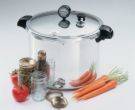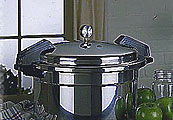
|
She's Gonna' Blow! Pressure Cookers - Part 2
by Patty Liston
 Just as promised, here is Part 2 dealing with pressure cookers. There is quite a bit of information, but all very useful if, like me, you are just being introduced to this cooking device. As mentioned last week, this information is from the Pressure Cooker Primer.
General Pressure Cooking Guidelines
Never fill your pressure cooker more than half full with foods or two thirds full of liquid. Foods have a tendency to increase in volume under pressure so it is important to never over fill your pressure cooker. Most cookers have a mark stamped on the inside that lets you know when you've put in the maximum amount.
For extra flavor, brown or sauté foods first just like you would when cooking with conventional methods. For instance brown the meat and onions for a soup, before adding other liquids and cooking.
Use less liquids than with conventional cooking methods. When cooking under pressure, less liquid evaporates than with conventional or stove top methods. Likewise slightly less liquid is usually required.
Add different ingredients at different times. Since food cooks so quickly, you will want to add slower cooking ingredients first, then later, release pressure, add faster cooking ingredients, seal and cook more. For some recipes with many ingredients, you may do this "stop and go" technique several times, but it's worth it so the finished products retains texture as well as flavor.
Be ready to adjust the stove heat. If the pressure builds too high, you will want to immediately lower the temperature so it comes down. This is easy on a gas range or even today's new electric models. However, if you have a standard electric stove, it's helpful to have one burner set on low heat while you build pressure in the cooker on another burner over high heat. Once you reach the desired pressure, move the pot to the burner with the lower heat in order to maintain the pressure at the desired level.
Begin counting cooking times when the pressure cooker has reached the full pressure, or PSI, called for in the recipe.
Estimate cooking times on the low side. Because foods cook so rapidly in the pressure cooker, a few extra minutes and they can turn to mush. If in doubt, check it out - release pressure, open the pot and test for doneness. If it's undercooked, you can always cook it more. If it's overcooked, you are stuck with it.
Increase cooking times slightly at high altitudes. You should be fine if you live at sea level to 2000 feet above sea level. After that, a good rule of thumb is to increase the cooking time by 5% for every 1000 feet higher than that 2000 foot base.
Releasing Steam
 You cannot open today's pressure cookers until you completely release the pressure from the pot: a huge safety improvement over the pressure cookers of yesteryear. Depending on what you're making, you will release steam, and therefore pressure, from your pressure cooker via the natural release or quick release methods. The recipe will tell you which is the preferred method. You cannot open today's pressure cookers until you completely release the pressure from the pot: a huge safety improvement over the pressure cookers of yesteryear. Depending on what you're making, you will release steam, and therefore pressure, from your pressure cooker via the natural release or quick release methods. The recipe will tell you which is the preferred method.
The Natural Release Method: This method means you remove the pressure cooker form the heat and wait for the pressure to slowly release as the temperature of the pot naturally lowers. Foods like soups or tough cuts of meat benefit from this extra cooking time, becoming more tender and flavorful.
Quick Release Method: Some pressure cookers have an automatic release method (check the instructions that came with yours). If so simply follow the instructions to release steam and pressure. If your pressure cooker does not have an automatic release method (and don't worry if it doesn't -- many do not), it's still simple to quickly release pressure. All you have to do is move the cooker from the stove to the sink and run cold water over the top side of the pressure cooker until the all the pressure is release It should take less than a minute.
Tips for Safe Pressure Cooking
 Too much pressure is created in one of three ways: the heat is too high; the pressure cooker is overfilled, the pressure regulator valve is obstructed or malfunctioning. Too much pressure is created in one of three ways: the heat is too high; the pressure cooker is overfilled, the pressure regulator valve is obstructed or malfunctioning.
Never fill your pressure cooker more than half full with foods or two thirds full of liquid. As steam builds up it needs space. Over filling your pressure cooker can result in food particles getting lodged in the valves, which can result in pressure not being released.
While it's important not to overfill the cooker, you must use enough liquid in order to build pressure. Usually at least 2 cups for larger pressure cookers.
Inspect the gasket or ring, making sure it is not dried out and still flexible (most manufacturers suggest replacing the gasket once a year). If the gasket is not in good shape, it will be impossible to attain a good seal and build pressure.
Inspect the valves to make sure they are free of debris and food residue. The instructions that came with your pressure cooker can tell you more thoroughly what to look for and how to maintain the valves.
Do not deep fry in your pressure cooker. It was not meant for this task and it can be dangerous as hot oil is highly combustible!
Cleaning and Storing Your Pressure Cooker
Take care of your pressure cooker and it will last you for a lifetime of great cooking. Here are some basic maintenance tips:
 Remove the rubber gasket or ring and wash this separately by hand. Remove the rubber gasket or ring and wash this separately by hand.
Never immerse the cover in water as it can clog and damage the safety valves.
Hand wash the pot by hand with your favorite dishwashing soap.
Do not store the pressure cooker with the lid locked in place as it can damage the rubber seal. Also if moisture is present it can create a seal that's difficult, if not impossible, to open.
You can conveniently store the pressure cooker pot with the lid placed upside down on top of it.
Adapting Regular Recipes for the Pressure Cooker
 You can cook most anything in the pressure cooker, although to be sure, it is better suited for foods that require long cooking times, such as soups, stews, beans and grain dishes. That said, I often make crisp-cooked steamed vegetables in my pressure cooker - the secret is to only cook them for a minute or two under pressure. You can cook most anything in the pressure cooker, although to be sure, it is better suited for foods that require long cooking times, such as soups, stews, beans and grain dishes. That said, I often make crisp-cooked steamed vegetables in my pressure cooker - the secret is to only cook them for a minute or two under pressure.
There are not many changes to make when adapting recipes for the pressure cooker. Just make sure you are using enough liquid to create steam (usually a minimum of 2 cups, you can get away with a little less for foods that cook quickly like steamed vegetables).
Sear meats and aromatic vegetables like onions for better flavor before closing the pressure cooker and cooking under pressure.
Other than that, the most important thing to monitor is the cooking time.
Pressure Cooker Clam Chowder
Vicki Smith
Serves 5
 1 quart shucked clams, or 3 cans (10 ounces each) minced clams with juice 1 quart shucked clams, or 3 cans (10 ounces each) minced clams with juice
1/2 pound thickly sliced bacon, diced
1 onion, minced
3 stalks celery, sliced
1 bottle (8 ounces) clam juice
2 potatoes, diced
1 teaspoon salt
1/2 teaspoon freshly ground black pepper
1/2 teaspoon ground thyme
1/4 teaspoon cayenne pepper
1 bay leaf
2 cups milk
2 cups cream or half and half
1/2 cup instant potato flakes
chopped green onion tops, for garnish
paprika for garnish
If using fresh clams, drain and chop the clams, reserving the liquid.
Heat the pressure cooker over medium heat and fry the diced bacon until it is crisp and the fat rendered. Remove the bacon and set aside. drain off all but 2 tablespoons of the bacon fat. Add the minced onions and the celery to the hot bacon fat in the cooker, and cook, stirring, until softened, about 3 minutes. Add the clams, clam juice, potatoes, salt, black pepper, thyme, cayenne pepper, and bay leaf. Stir to mix and lock the lid in place. Bring to 15psi over high heat, immediately reduce the heat to the lowest possible setting to stabilize and maintain the pressure and cook for 5 minutes.
Remove from the heat and use the natural release method to depressurize (see related links for pressure cooker instructions). Carefully open the lid after pressure drops. Discard the bay leaf. Add the milk, cream, and most of the crumbled bacon, reserving some bacon for garnishing. Bring to a simmer over medium heat, but do not boil. Add the potato flakes a little at a time, stirring as the chowder thickens to the desired consistency. Pour into a heated soup tureen and garnish with the green onions, a dusting of paprika, and the extra crumbled bacon.
Variation:
Add 1/2 pound fresh fish, shrimp, crabmeat, or lobster to make a seafood chowder.
Contribute to the Cook'n Club!
DVO would love to publish your article, prose, photography and art as well as your cooking, kitchen and nutrition tips, tricks and secrets. Visit the Newsletter Submission / Win Win for All section in our Forum for more information and details.
|
|



